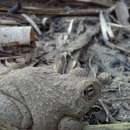Cyclicity
provided by IABIN
ano todo
Brief Summary
provided by IABIN
Diagnosis A stout medium-sized grayish frog, faintly dark-spotted above, white on the lower surface, with a short truncate snout, tympanum evident and shovel-like strongly projecting metatarsal tubercles.
- author
- Esteban O. Lavilla
- editor
- Diego Arrieta
Distribution
provided by IABIN
Occurs in Catamarca, Córdoba, La Pampa, La Rioja, Mendoza, Neuquen, Río Negro, Salta, San Juan, San Luis, Tucumán provinces in Argentina.
- author
- Esteban O. Lavilla
- editor
- Diego Arrieta
Morphology
provided by IABIN
herbacea
Life Cycle
provided by IABIN
perene
Reproduction
provided by IABIN
sementes
Diagnostic Description
provided by IABIN
Adult morphology Snout-vent of about 45 mm. Head wide and bulky; snout short, sharply truncate, protruding on the lower jaw. Nostrils terminal, opening antero-dorsally. Interocular distance subequal to the internarial interval and narrower than the upper eyelid. Canthus rostralis indistinct. Maxillary teeth weak; vomerine teeth absent. Eyes slightly laterally located. Tongue wide, subcordiform, free behind. Tympanum evident, round, 1/2 of the eye diameter. Supratympanic fold curved and glandular; a visible rounded gland at the mouth joint. Fingers moderately fringed; rate finger lengths: II-IV-I-III. A round inner metacarpal tubercle and a larger outer metacarpal tubercle evident. Toes webbed at the Base and widely fringed; subarticular tubercles faint. A very strong inner metatarsal tubercle, shovel-like and horny; a nearby outer metatarsal tubercle, also shovel-shaped. No tarsal fold present. When hindleg is adpressed, heel reaches the tympanum in males, the shoulder in females; when the femurs are bent at right angles to body, the tibio-tarsal articulations fail to meet. Skin smooth porous on the dorsum, scattered with blunt glandulous warts, longitudinally oriented. Ventrally smooth, with the under surface of thighs coarsely granular, Dorsum grayish scattered with dull gray rounded dots. Ventrally white, immaculate.
- author
- Esteban O. Lavilla
- editor
- Diego Arrieta
Behavior
provided by IABIN
cosmopolita
Conservation Status
provided by IABIN
LC. Least Concern.
- author
- Esteban O. Lavilla
- editor
- Diego Arrieta
Comprehensive Description
provided by Smithsonian Contributions to Zoology
Pleurodema nebulosa
The BFA and BRA papillae are organized in a central patch rather than bounding defined arenas and the BFA and BRA papillae are recurved with thick bases and caudally directed apices. The free edges of the ventral velum are recurved and lack papillae; however, the central portion forms an unusual apron overhanging the glottis. Secretory pits or ridges are absent.
The inner oral morphology of P. nebulosa is very distinctive among leptodactylids and is as different from the other Pleurodema examined as from all other genera studied. There are no external clues to the bizarre, internal, oral morphology of P. nebulosa.
The lack of organized secretory pits and ridges, together with but two filter cavities and the unusual buccal papillation and ventral velum, suggests something other than a normal pond tadpole. Among pond larvae only discoglossids and pelobatids have similar branchial food trap morphology. Larvae of the Asian pelobatid genus Megophrys have a somewhat similar recurved ventral velar margin (Wassersug, 1980). P. nebulosa's branchial baskets are also somewhat similar to those of pelobatids which have a single-filter cavity (= a bowl-like design). We are unable to predict the habitat or feeding type, as we have not encountered this kind of larval morphology previously. Mares et al. (1977) reported that the desert-dwelling species has a very brief larval life (about 10 days) and that the larvae are carnivorous and cannibalistic under stress. In retrospect, such features as the posteriorly directed BFA and BRA papillae may be interpreted as functioning to direct large or active prey into the esophagus. P. nebulosa appears convergent with pelobatids that breed in seasonally arid environments.
- bibliographic citation
- Wassersug, Richard J. and Heyer, W. Ronald. 1988. "A survey of internal oral features of Leptodactyloid larvae (Amphibia: Anura)." Smithsonian Contributions to Zoology. 1-99. https://doi.org/10.5479/si.00810282.457
Comprehensive Description
provided by Smithsonian Contributions to Zoology
Pleurodema nebulosa (Burmeister)
MATERIAL.—No number (2 specimens dissected, stage 35 and 37, SVL 11.2 and 14.5 mm respectively, former specimen illustrated). Collected from 20 km W Encan, San Juan, Argentina, 10 February 1977, by J.M. Cei.
REFERENCE.—Cei (1980:380, fig. 164) described and illustrated the external morphology and reported that the larva occurs in clayish water of lagoons and temporary summer pools in xerophilous scrub arid zones.
GENERAL
- bibliographic citation
- Wassersug, Richard J. and Heyer, W. Ronald. 1988. "A survey of internal oral features of Leptodactyloid larvae (Amphibia: Anura)." Smithsonian Contributions to Zoology. 1-99. https://doi.org/10.5479/si.00810282.457
Pleurodema nebulosum
provided by wikipedia EN
Pleurodema nebulosum is a species of frog in the family Leptodactylidae. It is endemic to Argentina. Its natural habitats are temperate shrubland, subtropical or tropical dry shrubland, temperate grassland, subtropical or tropical dry lowland grassland, subtropical or tropical seasonally wet or flooded lowland grassland, subtropical or tropical high-altitude grassland, intermittent freshwater marshes, arable land, pastureland, ponds, irrigated land, and seasonally flooded agricultural land.
References

- license
- cc-by-sa-3.0
- copyright
- Wikipedia authors and editors
Pleurodema nebulosum: Brief Summary
provided by wikipedia EN
Pleurodema nebulosum is a species of frog in the family Leptodactylidae. It is endemic to Argentina. Its natural habitats are temperate shrubland, subtropical or tropical dry shrubland, temperate grassland, subtropical or tropical dry lowland grassland, subtropical or tropical seasonally wet or flooded lowland grassland, subtropical or tropical high-altitude grassland, intermittent freshwater marshes, arable land, pastureland, ponds, irrigated land, and seasonally flooded agricultural land.
- license
- cc-by-sa-3.0
- copyright
- Wikipedia authors and editors

